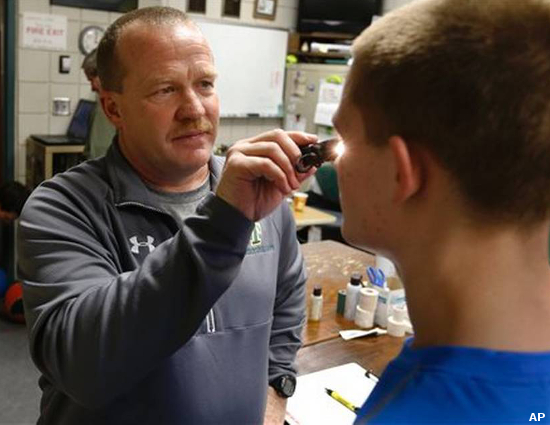- Senior Salute: Leland Gantz
- 2024 Final Leaders: Southeastern Indiana
- 2024 NKFCA Top 26
- 2024 OPSMA Division I All-Ohio Teams, Ponatoski tabbed as OPOY
- 2024 OPSMA Division II All-Ohio Teams; Burnam named Co-OPOY
- 2024 OPSMA Division III All-Ohio Teams
- 2024 OPSMA Division IV All-Ohio Football Teams; Taft’s Pavey named Co-DPOY
- 2024 OPSMA Division V All-Ohio Football Teams
- 2024 OPSMA Division VI All-Ohio Football Teams
- 2024 OPSMA Division VII All-Ohio Football Teams
Concussion protocol not being followed
- Updated: January 28, 2015

Criticized for its own handling of head injuries, the NFL launched an extensive lobbying campaign to pass laws protecting kids who get concussions while playing sports. The result: Within just five years, every state had a law on the books.
But are the laws strong enough?
An Associated Press analysis of the 51 youth concussion laws — one in each state and the District of Columbia — found that fewer than half contain all of the key principles in the initial bill passed in Washington state in 2009. That measure mandated education for coaches about concussion symptoms, removal from a game if a head injury is suspected, written clearance to return, and a concussion information form signed by parents and players.

NFL commissioner Roger Goodell poses with youth teams.
“We did make compromises … in some states where we wanted to get something. A ‘B’-level law, as opposed to an ‘A’-level law,” said NFL Senior Vice President of Health and Safety Policy Jeff Miller, who testified about concussions before Arizona’s legislature on Tuesday while in town for the Super Bowl.
“Better to get something good, and get something in place,” Miller said, “as opposed to shoot for something fantastic in all places — and fail.”
The laws were passed with remarkable speed, and many were weakened because of concerns about cost. Jay Rodne, the Republican who sponsored Washington’s initial law, said putting expensive enforcement mechanisms in the bills would have caused many to fail.
Judy Pulice, in charge of state legislation for the National Athletic Trainers’ Association, helped guide the NFL as bills were written and was disappointed that the final products didn’t include penalties for noncompliance.
“What happens if you don’t pull the kid out of the game? What happens if you put them back in with no medical release?” Pulice said. “Nothing happens.”
The AP’s review of the laws passed after Washington found that only 21 have all four of the requirements in the model legislation.
All but two of the laws call for the immediate removal of an athlete from a game or practice if a concussion is suspected. All but four contain language about education for coaches.
Yet only 34 say that before returning to action, an athlete with a head injury must have written clearance from a licensed health care provider trained in the evaluation and management of concussions. Just 30 mandate that a concussion information form be signed both by the athlete and a parent or guardian.
“They don’t all have the (main) principles. Not every state has the same bite as Washington state,” said Dr. Richard Ellenbogen, chairman of neurological surgery at the University of Washington and co-chairman of the NFL head, neck and spine committee.
He treated Zackery Lystedt, the middle-school football player who nearly died after getting two concussions in a game. Washington’s law was named for the teen.
After that landmark bill was passed, Ellenbogen recalled, he had a conversation with NFL Commissioner Roger Goodell about efforts to replicate the legislation elsewhere.
“The commissioner asked me, ‘What do (you) want to get out of this?’ I said, ‘I want to see, in my lifetime, 10 more states pass a Zack Lystedt law,'” Ellenbogen said. “And he said, ‘No. We’re going to get all 50 states. And we’re going get them in under five years.'”
Despite the weaknesses in a majority of the laws, there does seem to be consensus that their passage has increased awareness.
The NFL’s Miller pointed out they can always be amended.
“I say, ‘Let’s go back and make them better.’ That’s OK, too,” he said. “There’s only 10 laws that are etched in stone and those are the Ten Commandments. Everything else can be changed. Everything else can be improved.”
JOIN THE HSFB100 DISCUSSION: Create a user name | Post on The Varsity Board


You must be logged in to post a comment Login